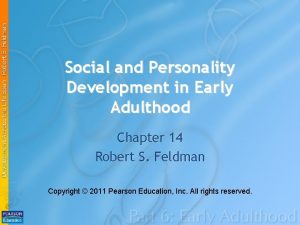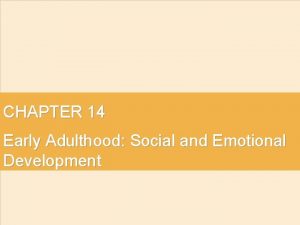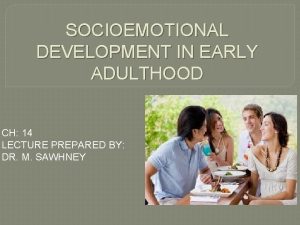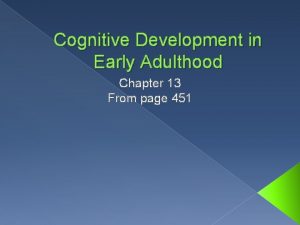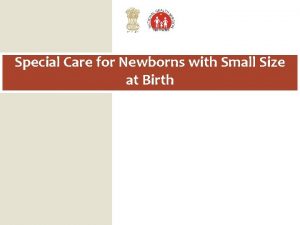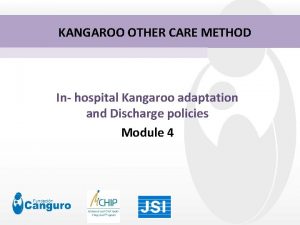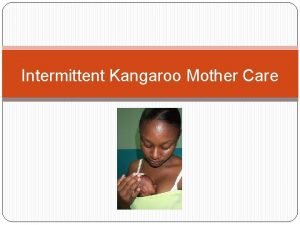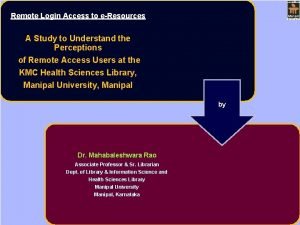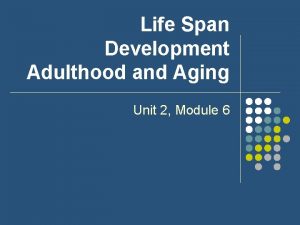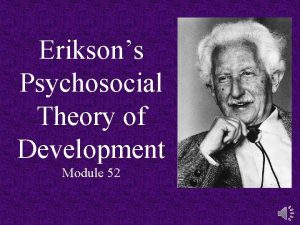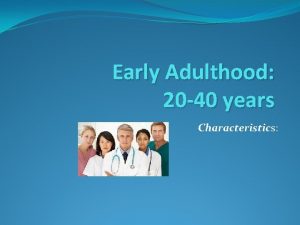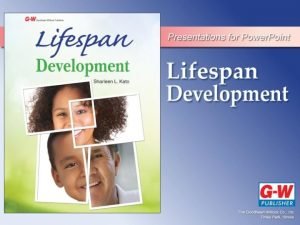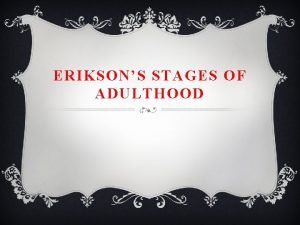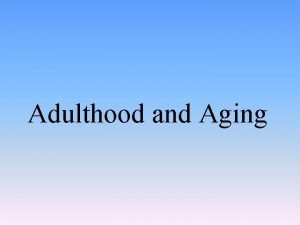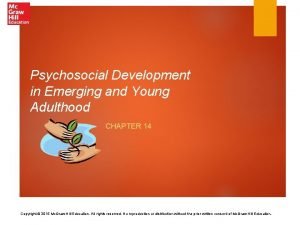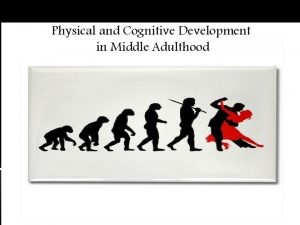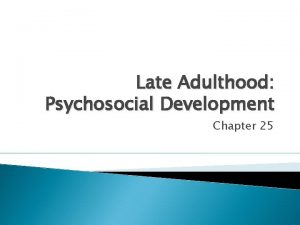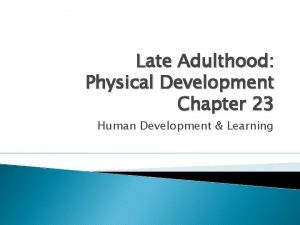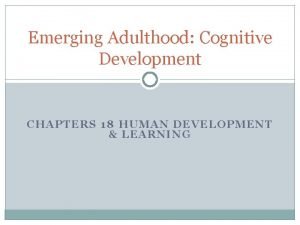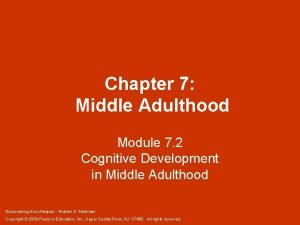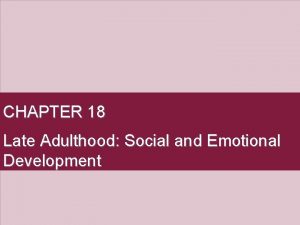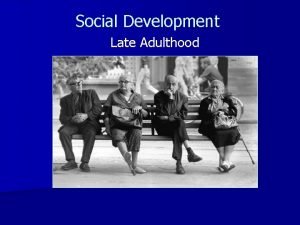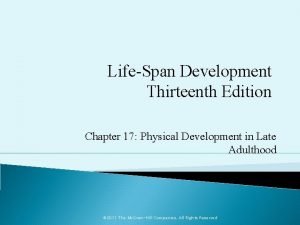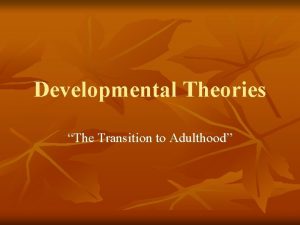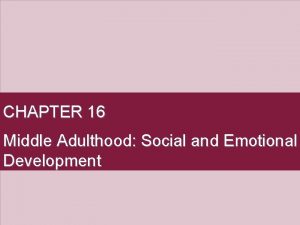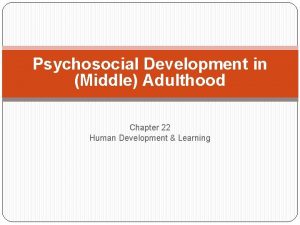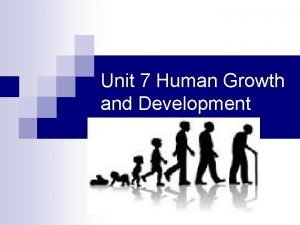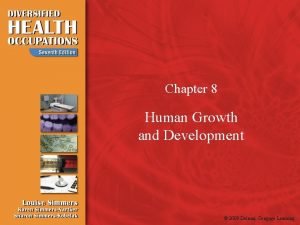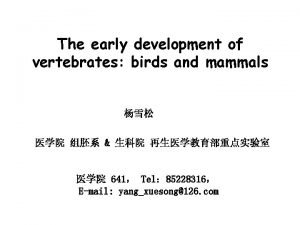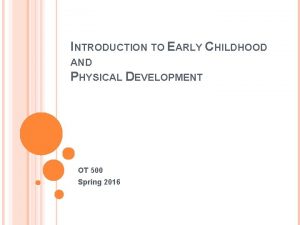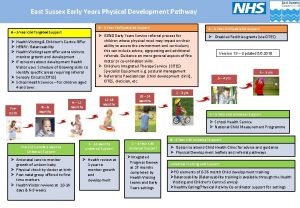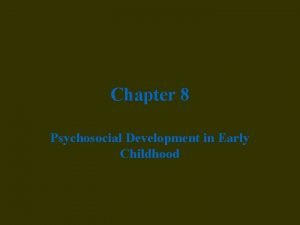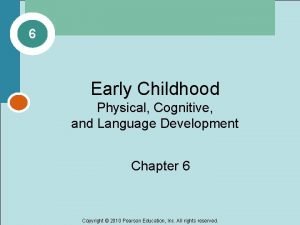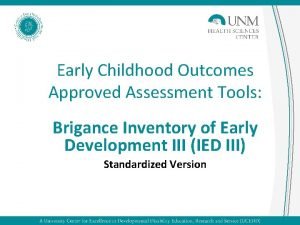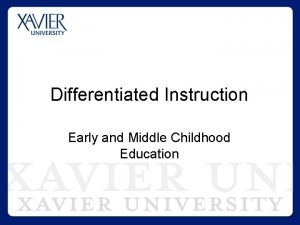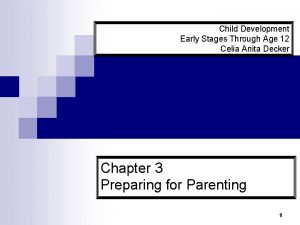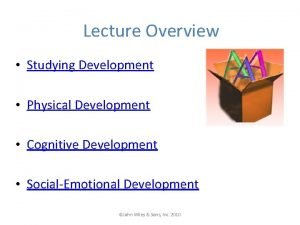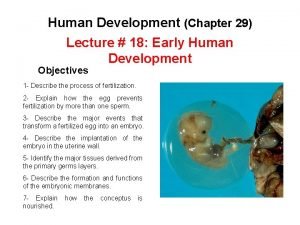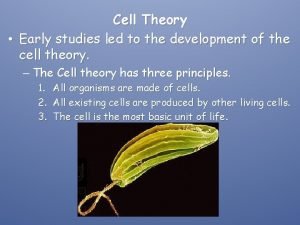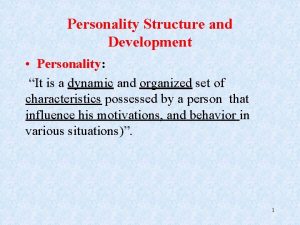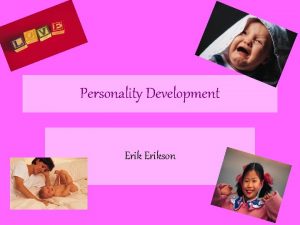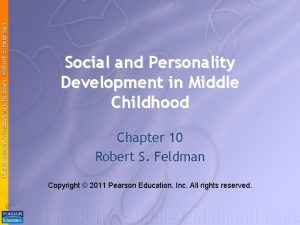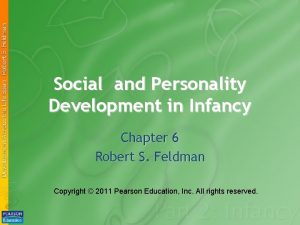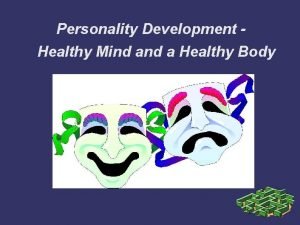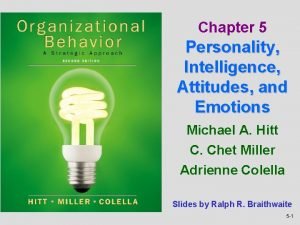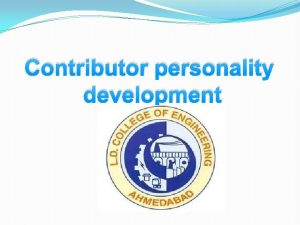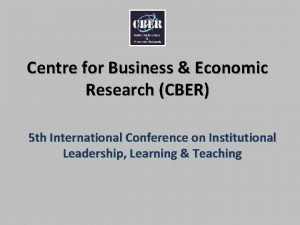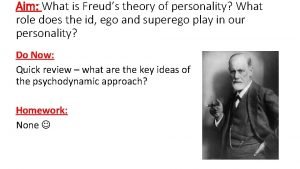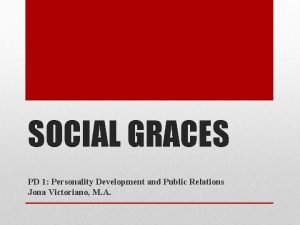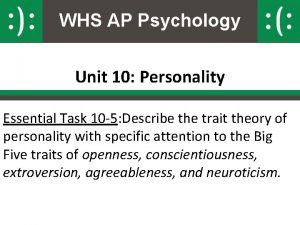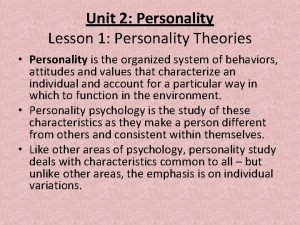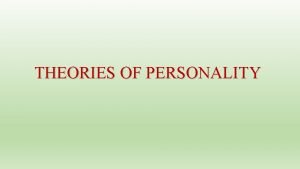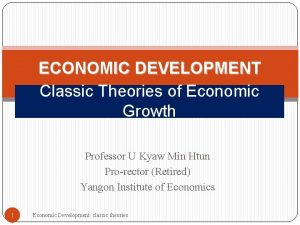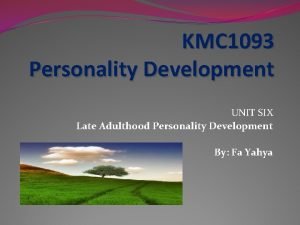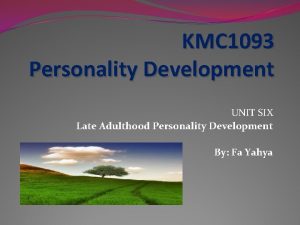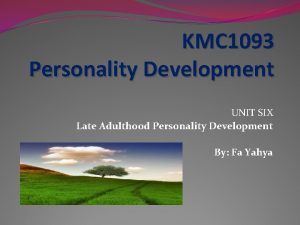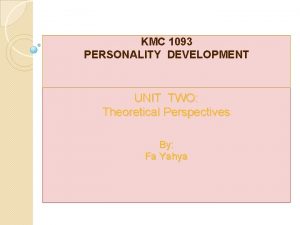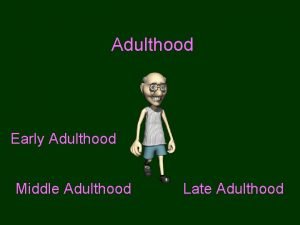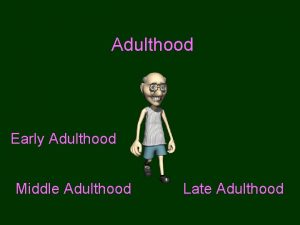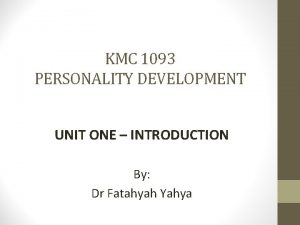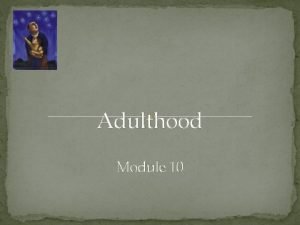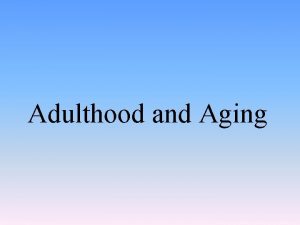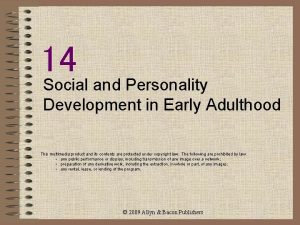KMC 1093 PERSONALITY DEVELOPMENT UNIT FOUR Early Adulthood





















































































- Slides: 85

KMC 1093 PERSONALITY DEVELOPMENT UNIT FOUR Early Adulthood Personality Development By: Fa Yahya

Table Of Content • • Development Across The Life Span Social Clock: Ravena Helson Social And PD In Adulthood : Daniel Levinson Intimacy Vs Isolation: Erikson Relationship Development: Bernard Mursntein Triangular Theory Of Love: Robert Sternberg Selecting A Partner – – – • Marriage Conflict Divorce Career – – – – Choose And Embarking On Career Identity During Young Adulthood Career Development Holland’s Theory Ginzberg’s theory Gender And Career Choice Why People Work Career Transition

Learning Unit Objectives • Discuss about the personality development of early adulthood. • Explain Social clock: Ravena Helson, Social and PD in adulthood : Daniel Levinson, Intimacy vs Isolation: Erikson, Relationship development: Bernard Mursntein and Triangular Theory of Love: Robert Sternberg • Discuss on issues about selecting a Partner as well as Marriage, Conflict in marriage and divorce • Discuss issues related to Career.

Development Across the Lifespan • What makes people happy? Money? Materials? Objects? • According to research, happiness in young adulthood is usually derived from feelings of independence, competence, or self-esteem (Sheldon et al, 2001). • Therefore, the components of happiness: Fulfillment of psychological needs.

• Building relationships in Early Adulthood: Liking and Loving • During early adulthood, romance, love, marriage and children are often the focus of life. • The development and course of relationships are emphasized. • Having children, receiving a promotion at work, and getting divorced are examples of events that mark a moment in adulthood on the social clock of life.

• The social clock describes the psychological timepiece that records the major milestone in people’s lives. • It provides us with a sense of whether we have reached the major markers of life early, late, or right on time compared to our peers.

Ravenna Helson : Social Clocks… • Ravenna Helson: “Following a socially acceptable & justifiable social-clock pattern may be the key to personality development in adulthood. ” • Individuals create an internal calendar of goals that they hope to accomplish at various points in their life. w It provides us with a sense of whether we have reached the major markers of life early, late, or right on time compared to our peers. w Examples of events that mark a moment in adulthood on the social clock of life: w Having children w receiving a promotion at work w getting divorced w Getting engaged w pursuing MA @ PHD level • Social clocks are culturally determined!

• In early adulthood the feminine social clock often begins to urge marriage, childbirth and building a family. • Alternatively, the masculine social clock pushes for career development. • Despite the social clock's gender-specific names, men and women can experience either. Success in one's attempt to meet the goals of a social clock can have a major impact on emotional development. – For example, a man subscribing to the feminine social clock who fails to find a partner and build a family during early adulthood is likely to experience a decline in self-esteem.

REFLECTION • Think of yourself, where are you with regards to your social clock? • Do you already get what you want? OR still do not know what you want in your life?

Social and Personality Development in Adulthood (Daniel Levinson)

Levinson's Life Structure Theory: Theories of Life Stages and Human Development • Suggests that development and growth happens well into the adult years. • At the center of Levinson's theory is the life structure. This is an underlying pattern of an individual's life at any given point in time. A person's life structure is shaped mainly by their social and physical environment, and it primarily involves family and work. Other variables such as religion, race, and status are often important as well.

In his theory there are two key concepts: The Stable Period • This is the time when a person makes crucial choices in life. The Transitional Period • This is the end of a person's stage and the beginning of a new one. Life during these transitions can be either unsteady or smooth, but the quality and significance of one’s life commitments often change between the beginning and end of a period.

• Levinson's model contains five main stages. – – – pre-adulthood stage (age 0 - 22), early adulthood stage (age 17 - 45), middle adult stage (age 40 - 65), the late adulthood stage (age 60 - 85) late adult stage (age 80 plus). • Levinson states "the shift from one era to the next is a huge development step and require transitional period of several years. “ (Levinson, 1977). • This would explain why there is an overlap in each of these stages.

Daniel Levinson: The stages of the seasons of a Man’s Life 17 -22: Early Adult Transition / Leaving the Family: �Transition from adolescence to adulthood. Gain physical and psychological distance and independence from the family. Begin to form the "dream" – a personal vision of one's own future. 22 -28: Entering the Adult World: �Exploration of occupational and interpersonal adult roles. Man arrives at an initial definition of himself as an adult. Begin work and family life, relying on support from spouse and mentor. A time of hard work.

28 -33: Age of transition : � changes occur in life structure, either a moderate change or, more often, a severe and stressful crisis 33 -40: Settling down : �establish a niche in society, progress on a timetable, in both family and career accomplishments; are expected to think and behave like a parent so they are facing more demanding roles and expectations

• Young adults frequently make sacrifices, such as a lower standard of living, for the opportunity to leave home. This allows a new level of independence and self reliance. Despite this, most young adults will move back home after a period away whether it's after college graduation or during times of financial hardship.

• Those in especially tense households tend to move out at an earlier age, while those in poverty leave later. Leaving home can result in strong emotional growth if done at the right time. Many young adults who choose to leave home too early are unable to attain as much education as their peers, and find less success in their careers.

How does this theory apply to society? • There a number of attitudes expressed which would appear to have an affect on society. • Firstly, many people are making the transition from youth to adulthood without any hope or optimism. This says that society as a whole throughout this age bracket is lacking enthusiasm and drive. • When men near the age of thirty, they have new expectations in society such as to provide for their children and aging parents. They are seen more as fathers than they were previously. • The episode of a culminate event in a man's life surfaces the midlife transition stage. When this happens, men usually become interested in acts of humanitarianism, and they are more cautious as they come to terms with the reality of death.

Problems with Levinson's theory: • Daniel Levinson collected the data for his study many decades ago, shortly after the Great Depression ended. Due to the time period, the men used for this study have 3 things in common: 1) they come from stable families 2) they had realistic goals for their life 3) became adults in an expanding economy • Men who have grown up in the last four or five decades , however, have had to deal with less stable families due to high divorce rates, and they tend to have goals which are much more difficult to achieve. They have also had to deal with a fluctuating economy, and because of these differences it is difficult to apply Levinson's studies to today's generation.

ERIKSON Stage 6: Young Adulthood • Age: Young Adulthood • Conflict: Intimacy vs. Isolation • Important Event: Love relationships

• The search for intimacy is the critical issue of the young adult period as opposed to isolation. • This refers to the desire for a stable long-term relationship and one’s ability to relate to another human being on a deep, personal level. Those who have achieved intimacy are thought to host a range of positive attributes, such as confidence and acceptance • Alternatively, those stuck in isolation are more likely to fear loneliness and abandonment. • Intimacy requires an individual to sacrifice some of their independence for another person. • After successfully traversing the struggle of isolation and intimacy an individual will deal with generativity, which is the desire to improve society for future generations.

• In this stage, the most important events are love relationships. • It is important to mention that having a sexual relationship does not indicate intimacy and having love relationship. • People can be sexually intimate without being committed and open with another. • True intimacy requires personal commitment. However, mutual satisfaction will increase the closeness of people in a true intimate relationship.

• Elements for a positive outcome: – The young adult must develop intimate relationships with others. – Not resolving this conflict leaves the young adult feeling isolated. – The young adult must be willing to be open and committed to another individual.

• Elements for a negative outcome: – An individual may retreat into isolation if a sense of identity is not developed and will fear a committed relationship. – Erikson suggests that those who experience difficulties during this stage are often lonely and isolated, and fearful of relationships with others.

Aspects of Intimacy: Erikson Aspects of Intimacy Explanation Selflessness Sacrifice of one’s own needs for others Sexuality Joint pleasure for the gratification of one’s self and one’s partner Devotion Fusing(combine) one’ identity with one’s partner

• As women and men move through early adulthood, they encounter significant developmental challenges in their lives – Building careers, families, and relationships • One of the primary developmental concerns that young adults face is whether and when to marry

• The importance of intimate friendship and romance formed during early adulthood stems from the valuable and adaptive contribution dialogues made with friends during adolescence. • Personality differences can be identified by capacities to form intimate relationships characterized by commitment, depth, and partner individuation based on interactions of early life.

• Although Erikson’s approach has been influential, developmentalists criticize some of his ideas… – Erikson’s view of healthy intimacy was limited to heterosexuals – Couples without children and alternative partnerships were viewed as deviations from the ideal – The theory also focused more on men's development than women's

Bernard Murstein : The Development Of Relationships • • Stimulus-Value-Role Theory (SVR) proposed by Bernard Murstein suggests that couples progress through three stages in mate selection. stimulus stage – The potential mates perceive each other’s external attributes, physical appearance, and behavior , and each also evaluates his or her own attributes in terms of how attractive they might be to the partner. – Based upon this comparison, the individuals estimate the likelihood that their attraction will be reciprocated and that future interaction with the other will be rewarding. – If this estimate is favorable (i. e. , if each believes that the other will like him or her and find his or her attributes desirable, and if each thinks that additional interaction will be rewarding), then the individuals are propelled into the next stage.

• value stage – occurs between the second and seventh encounter and is characterized by increasing similarity of values and beliefs. – During the value stage, the partners appraise their compatibility on various values and attitudes. – This process of value appraisal allows them to continue to assess the potential benefits or rewards of the relationship.

• role stage – is built on specific roles played by the participants (e. g. boyfriend/girlfriend). – Role assessments are made during and after the eighth encounter.

Problem With SVR Theory: • Although historically interesting, stage models of relationship development have fallen out of scientific favor for a number of reasons: – First, stage theorists do not agree on the number, the sequence, or even the characteristics of the various stages of courtship. – Second, not all relationships progress through the same stages. – Third, couples differ in the rate at which they pass through particular courtship stages. – Fourth, a number of process models have been developed that seem to more accurately capture the how and why of relationship progression

Friendship • Maintaining relationships with friends is an important part of adult life. – Need for belongingness • How do we choose our friends? – Proximity (accessibility) – Similarity (values, attitudes, ethnicity, etc. ) – Personal qualities (trustworthy, loyal, warm, supportive, honest, funny, etc. )

Romantic Love • Success or failure in the search for romantic love plays an important role in the emotional development of young adults. • Those in satisfying relationships report improved self-esteem and well-being, while those who search unsuccessfully experience the opposite.

• • • Increasing evidence suggests that infant attachment styles are reflected adult romantic relationships. According to Phillip Shaver, the influence of infants' attachment styles continues into adulthood and affects the nature of their romantic relationships. Within a relationship there are 3 types of generally recognized attachment – Secure Attachment • experience trusting relationships and consider their partner a friend as well as a lover. • readily enter into relationships and feel happy and confident about the future of the relationship (half of all adults). – Avoidant Attachments • consist of mistrust and a cold emotional connection. This can result in other issues such as infidelity and alcoholism. • tend to be less invested in relationships, have higher break-up rates, and often feel lonely (one quarter of all adults). – Anxious-avoidant Attachment • tend to become overly invested in relationships, have repeated break-ups with the same partner, and have relatively lose self-esteem (20 percent of adults).

Falling in Love: Social & Personality Development in Young Adulthood • Two people interact with each other more often and for longer periods of time. • Two people increasingly seek out each other's company. • They open up more and begin to share physical intimacies.

• Couple is more willing to share positive and negative feelings, criticize and praise. • They begin to agree on the goals they hold for the relationship. • Their reactions to situations become more similar. • They begin to feel their psychological well-being is tied to success of relationship, viewing it as unique, irreplaceable, and cherished.

• Most developmental psychologists would argue that love is not just "a lot of liking" • It involves intense physical arousal. • It involves an all-encompassing interest in another person.

• It involves recurrent fantasies about the other individual. • It involves rapid swings of emotion. • It includes elements of closeness, passion, exclusivity Not all love is the same! We love different people in different ways…

• According to Elaine Hatfield and Ellen Berscheid's LABELING THEORY OF PASSIONATE LOVE, individuals experience romantic love when two events occur together: intense physical arousal and situational cues that indicate that "love" is the appropriate label for the feelings being experienced

Robert Sternberg's Triangular Theory of Love

• Hypothesizes that love is made up of three components The INTIMACY COMPONENT The PASSION COMPONENT The DECISION/ COMMITMENT COMPONENT • encompasses feelings of closeness, affection, and connectedness. • comprises the motivational drives relating to sex, physical closeness, and romance. • embodies both the initial cognition that one loves another person and the longer-term determination to maintain that love.

• 8 unique combinations of love can be formed: ( not all love is the same… we love different people in different way…) 1. Non love : occurs in absence of all 3 component ( intimacy, passion, decision/commitment) 1. Liking : develops only when intimacy is present 2. Infatuated: love exist for those who only feel passion 3. Empty love: develops when only decision/commitment is present 4. Romantic love: intimacy+ passion present 5. Companionate love : intimacy + decision/commitment present 6. Fatuous love : passion + decision/commitment present 7. Consummate love : 3 components are present

• Many people mistakenly think that consummate love represents "ideal love" in Sternberg’s theory, since all 3 components of love are present. • Many long lasting and happy relationships are based on types of love other than consummate • The type of love that dominates a relationships varies over time • Decision/commitment and intimacy can continue to grow over time (important in strong, loving relationships) • Passion tends to peak early, decline, and level off.


Selecting a partner: Is love the only thing that drives your attention? • The search for a partner is often a major developmental track during young adulthood. • The emphasis on love in choosing a marriage partner varies. • Research study (Levine, 1993): "Would you marry someone that you didn’t love? " – College students in U. S. , Japan & Brazil: NO – College students in Pakistan & India: YES – UNIMAS STUDENTS: ? ? ?

Seeking a Spouse • In the U. S. , people emphasize love as a major factor • In other cultures, love may be a secondary consideration (Pakistan, India), although still relatively high on the list of important characteristics according to research. • What else matters? – Emotional maturity, health, similar education, chastity are among the top 18 in a study by Buss, 1990.

What Are Other Important Characteristics Rather Than Love? • VARIES! – U. S. —love and mutual attraction – China---men: good health – Women: emotional stability & maturity – South Africa/Zulu—men: emotional stability, women: dependable character – Malaysian Culture: ? ? ?

• Gender differences in preferred characteristics exist – Men prefer physical attraction – Women prefer ambition, industriousness • Why? – Psychologist David Buss points out that human beings, as a species, seek out certain characteristics to maximize beneficial genes and reproductive success—Evolutionary explanation!

• Surveys may assist in identifying general qualities valued in a spouse, but are less able to explain how specific individuals are chosen. • Psychologists Louis Janda & Karen Klenke. Hamel (1980) emphasize a Filtering Model of Spouse Selection • Assumes that people seeking a mate use increasingly stringent/tough filtering process…

Filtering Models of Mate Selection • Louis Janda and Karen Klenke-Hamel suggest that people seeking mates screen potential candidates. – First, we filter for broad determinants of attractiveness, and work our way to specifics: • • Residential proximity Similarity/complementary Interpersonal attractiveness The end result is a choice based on compatibility between two individuals.

What determines compatibility? • Pleasing personality characteristics are not the only factors. Cultural components play a role. – People often marry according to the principle of HOMOGAMY, or the tendency to marry someone who is similar in age, race, education, religion, and other basic demographic characteristics – The dominant standard in most marriages in the U. S. – Another societal standard for marriage partner selection…

MARRIAGE GRADIENT • The MARRIAGE GRADIENT is the tendency for men to marry women who are slightly younger, smaller, and lower in status, and women marry men who are slightly older, larger, and higher in status. • Well-educated African-American women find it difficult to find a spouse according to the marriage gradient (may marry less educated men or not marry). • Men have a larger pool to choose from.

Why Do Some Couples Choose To Cohabitate Rather Than Marry? • Some feel they are not ready for a lifelong commitment • Practice for marriage • Against the institution of marriage (outdated, unrealistic, etc. ) • Those who feel that cohabitating increases their chances of a happy marriage are incorrect according to research; the chances of divorce are slightly higher for those who have cohabitated

• The past three decades have seen a dramatic rise in couples living together without being married, a status known as COHABITATION. • They are young people – 40% are under age 25. • Despite the prevalence of cohabitation, marriage remains the preferred alternative • The median age for first marriage in the U. S. is 26 for men and 24 for women (the oldest age for women since records started in the 1880’s) • The delay represents economic concerns and commitment to establishing a career (NOT the death of a social institution). • 90 % of people eventually wed. • 9 out of 10 - eighteen year olds say a happy marriage is important for having a good life

Why Do Couples Choose to Marry? • Appropriate culmination of love • The right thing to do after reaching a particular age • Significant emotional, financial, and health benefits • Filling a sexual role • Therapeutic and recreational role • Offers children

What makes marriage work? • According to John Gottman, the crucial factors that affect whether a marriage ends in divorce include: • Affection displayed toward spouse • Amount of negativity communicated to the spouse • Expansiveness or expressivities in communicating information about the relationship

• A sense of "we-ness", or perceiving oneself as part of an interdependent couple, rather than as one of two separate, independent individuals • Social homogamy (similarity in leisure activity and role preferences • In spite of this, ½ of all marriages end in divorce (worldwide epidemic)

Early Marital Conflict • Initial idealization of partner and then becoming aware of flaws • Difficulty making the transition from children to independent adults • Difficulty developing an identity apart from spouse • A baggage from the past • Poor communication skills • Working hard to change the other person • Focusing on one’s own needs • Setting high expectations • Holding a grudge • Mismanaging of time • Roles are not well-defined

Can divorce be predicted? • According to Gottman, evidence shows that certain factors very accurately predict a later divorce. • The greatest likelihood of divorce occurred in cases in which husbands were low in affection, "we-ness", and expansiveness and high in negativity and disappointment.

• Wives' best predictors of divorce were low "we-ness" and high disappointment. • Divorce is more likely if spouses habitually attribute negative events to their partners. • The best single predictor of divorce was the degree of disappointment the husband felt about the marriage.

• Divorce is increasing around the world • Although divorce and its consequences will be considered when we discuss middle age, divorce is a problem that has its roots in early adulthood & the early years of marriage. • Most divorces occur during the 1 st 10 years of marriage.

The Effects of Parenthood on Social & Personality Development in Early Adulthood • The arrival of a child alters virtually every aspect of family life, in positive, and sometimes negative ways. • What makes a couple decide to have a child? • One estimate: A middle class family with 2 children spends about $100, 000 for each child up to age 18 ($200, 000 with college)- large expenses

• Young adults typically cite psychological reasons for having children: – pleasure watching them grow – fulfillment from children's accomplishments – satisfaction from seeing them become successful – enjoyment of creating a close bond – someone to take care of them in their old age – someone to maintain the family business – companionship – a strong societal norm - 90% have a child

• For some couples, the decision to have children is inadvertent/involuntary. • Unwanted pregnancies occur most frequently in younger, poorer, and less educated couples. • The use of contraceptives has dramatically decreased the number of children in the average American family. • Family planning practices.

• The fertility rate has declined from its all-time high post WWII level of 3. 7 children per woman to below 2. 0, which is less than the replacement level (the number of children that one generation must produce to replenish its numbers). • More women are using contraceptives. • More women are working. • Women are delaying having children until their 30 s.

• For many couples, marital satisfaction takes a dive after a new baby. • Wives have more responsibilities. • Husbands feel they take second fiddle to baby. • Some couples feel greater satisfaction after having a child • Especially true for couples with realistic expectations about the responsibilities involved in childrearing

CAREER – Choose And Embarking On Career – Identity During Young Adulthood – Career Development – Holland’s Theory – Ginzberg’s theory – Gender And Career Choice – Why People Work – Career Transition

Work: Choosing and Embarking on a Career • For most people, early adulthood is a time of making decisions that will have lifelong implications • One of the most critical choices made during this period: choosing a career path • The choice has implications for identity and sense of self-worth

Identity During Young Adulthood: The Role of Work • According to George Vaillant, young adulthood is marked by a stage of development called CAREER CONSOLIDATION, a stage that is entered between the ages of 20 and 40 when young adults become centered on their careers. • Vaillant argued that career concerns supplant the focus on intimacy. • Critics argue that Vaillant's sample was limited to elite men from the 1930 s, and that his results are not generalizable to today's young adults.

Career development • Career development has a major impact on emotional changes in early adulthood. As young adults leave their parents home and become financially independent, the growth of a career or the pursuit of further education gain special importance. • Men are more likely to put a heavy investment into these goals, while women are more often split between family and career development. Because of these investments, a successful career tends to result in healthy emotional development and high self-esteem, especially in men.

Holland’s Personality Type Theory: How an Individual’s Personality Affects Career Decisions • According to John Holland, certain personality types match particularly well with certain careers. • Realistic. These people are down-to-earth, practical problem solvers, and physically strong, but their social skills are mediocre. They make good farmers, laborers, and truck drivers. • Investigative. Intellectual types are oriented toward theoretical and abstract. Although not particularly good with people, they are

• Social. The traits associated with the social personality type are related to verbal skills and interpersonal relations. Social types are good at working with people, and consequently make good salespersons, teachers, and counselors. • Conventional individuals prefer highly structured tasks. They make good clerks, secretaries, and bank tellers.

• Enterprising. These individuals are risk-takers and take-charge types. They are good leaders and may be particularly effective as managers or politicians. • Artistic types use art to express themselves, and they often prefer the world of art to interactions with people. They are best suited to occupations involving art.


Ginzberg’s Theory of Career Development • Viewed vocational choice as irreversible process occurring in reasonably clearly marked periods and characterized by a series of compromises the individual makes between wishes and possibilities – people typically move through a series of stages in choosing a career

3 major periods of the process • FANTASY PERIOD – which lasts until age 11, and is the period when career choices are made, and discarded, without regard to skills, abilities, or available job opportunities. • TENTATIVE PERIOD – which spans adolescence, people begin to think in pragmatic terms about the requirements of various jobs and how their own abilities might fit with them. • REALISTIC PERIOD § during which people explore specific career options. Critics argue that Ginzberg's theory is too simple

• Women today are under-represented in male dominated professions such as engineering and computer programming. • Women in many professions earn less than men in identical jobs. • BUT, in ½ of all U. S. households women earn as much as their husbands

Gender & Career Choices • Although it is now illegal to advertise a position for a man or a woman, but traditional gender-role prejudice persist. • Traditionally, women were considered most appropriate for COMMUNAL PROFESSIONS, occupations associated with relationships. • In contrast, men were perceived as best suited for AGENTIC PROFESSIONS, occupations associated with getting things accomplished.

Why do people work? More Than Earning a Living • • • Extrinsic motivation Intrinsic motivation Personal identity Social lives Status

Motivation to Work • • Satisfaction on the job The job itself Variety Influence over others Supportive relationships Useful feedback Opportunities offered Clear and consistent rules

Adults in Career Transition • Career change has become more socially acceptable as personal fulfillment is more highly valued • careers may be viewed as a spiral sequence of all life roles, with changes triggered by factors ranging from the anticipated (marriage, empty nest) to unanticipated (illness, divorce, layoff) to "nonevents" (a marriage or promotion that did not occur) • Personal reactions to transition vary. – Whether the career change is voluntary or involuntary, people may experience a variety of emotions such as fear, anxiety, or a sense of loss. – Phases of transition may include denial, self-doubt, letting go, testing options, searching for meaning, and integration and renewal

Helping Adults In Career Transition • According to Sargent and Schlossberg (1988), adult readiness for change depends on four factors: self, situation, support, and strategies. – – (1) self: personal responses to change; (2) situation: changes in roles, relationships, routines, assumptions; (3) support: does a range of sources exist? were they disrupted by transition? ; (4) strategies: taking action to change the situation, change its meaning, or change oneself.

Coping Skills A variety of coping skills for managing transition are necessary (Leibowitz and Lea 1985). These skills include: • perceiving and responding to transitions • developing and using internal and external support systems • reducing emotional and physiological distress • planning and implementing change

Summary • Early adulthood, consists of substantial changes in the daily life of an individual. Within these years most young adults will finish school and choose to enter the workforce full-time or pursue further education. • Regardless of an individual's choice, many aspects of their emotional development will be the same. • Theorists place great emphasis on strengthening romantic relationships and defining one's life goals during this period of rapid change.
 Social and personality development in early adulthood
Social and personality development in early adulthood Early adulthood cognitive development
Early adulthood cognitive development Middle adulthood physical changes
Middle adulthood physical changes Social development early adulthood
Social development early adulthood Cognitive development during early adulthood
Cognitive development during early adulthood Socioemotional development in early adulthood
Socioemotional development in early adulthood Labouvie-vief pragmatic thought
Labouvie-vief pragmatic thought Chemsheets condensation polymers
Chemsheets condensation polymers P 1093
P 1093 Kmc position image
Kmc position image Kmc position image
Kmc position image Kmc position image
Kmc position image Kmc chart
Kmc chart Kmc agro
Kmc agro Kmc library proxy
Kmc library proxy Kmc register
Kmc register Early adulthood age erikson
Early adulthood age erikson Early adulthood age erikson
Early adulthood age erikson Characteristics of early adulthood stage
Characteristics of early adulthood stage Early adulthood age
Early adulthood age Early adulthood milestones
Early adulthood milestones Early adulthood milestones
Early adulthood milestones Early adulthood age
Early adulthood age Emerging adulthood psychosocial development
Emerging adulthood psychosocial development Cognitive development in middle adulthood
Cognitive development in middle adulthood Middle adulthood physical development
Middle adulthood physical development Late adulthood psychosocial development
Late adulthood psychosocial development Physical development in late adulthood
Physical development in late adulthood Late adulthood cognitive development
Late adulthood cognitive development Most productive life stage
Most productive life stage Emotional development is often stormy and in conflict
Emotional development is often stormy and in conflict Social development
Social development Emerging adulthood cognitive development
Emerging adulthood cognitive development Cognitive development in middle adulthood
Cognitive development in middle adulthood Later adulthood emotional development
Later adulthood emotional development Socioemotional development in late adulthood
Socioemotional development in late adulthood Disengagement theory
Disengagement theory Physical development in late adulthood
Physical development in late adulthood Fraction definition
Fraction definition Which way now
Which way now Social development in middle adulthood
Social development in middle adulthood Middle adulthood psychosocial development
Middle adulthood psychosocial development Social changes in late adulthood
Social changes in late adulthood Chapter 8:1 life stages
Chapter 8:1 life stages Early cpr and early defibrillation can: *
Early cpr and early defibrillation can: * Unit 10, unit 10 review tests, unit 10 general test
Unit 10, unit 10 review tests, unit 10 general test Early development in birds
Early development in birds Fine motor skills development in early childhood
Fine motor skills development in early childhood Quiz 1: development of industrial revolution
Quiz 1: development of industrial revolution Physical development in early childhood
Physical development in early childhood Psychosocial development in early childhood
Psychosocial development in early childhood Language development in early childhood
Language development in early childhood Brigance inventory of early development iii
Brigance inventory of early development iii Early childhood is ____ for language learning
Early childhood is ____ for language learning Biosocial development in early childhood
Biosocial development in early childhood Brigance screening 3 year-old
Brigance screening 3 year-old Early childhood development with differentiated instruction
Early childhood development with differentiated instruction Child development early stages through age 12
Child development early stages through age 12 3 stages of prenatal development
3 stages of prenatal development Secondary oocyte
Secondary oocyte Early studies led to the development of the cell theory
Early studies led to the development of the cell theory Kandinskey
Kandinskey Four eyes skin assessment tool
Four eyes skin assessment tool Unit 6 early 20th century ga
Unit 6 early 20th century ga Splitting defense mechanism example
Splitting defense mechanism example Mistrust vs trust
Mistrust vs trust Physical defects in personality development
Physical defects in personality development Personality development in infancy
Personality development in infancy Personality development in middle childhood
Personality development in middle childhood Personality development in infancy
Personality development in infancy Summary of personality development
Summary of personality development Determinants of personality development
Determinants of personality development Example of contributor personality
Example of contributor personality Conclusion of personality
Conclusion of personality Freud's psychosexual development of personality youtube
Freud's psychosexual development of personality youtube Social graces
Social graces Contributor personality development
Contributor personality development Unit 10 ap psychology
Unit 10 ap psychology Tat test ap psychology
Tat test ap psychology Unit 2 lesson 1 what is personality
Unit 2 lesson 1 what is personality The structural unit of personality is
The structural unit of personality is Projective test example
Projective test example Dualistic development thesis
Dualistic development thesis Four stages of language development
Four stages of language development Four theories of language development
Four theories of language development The cpi crisis development model
The cpi crisis development model
